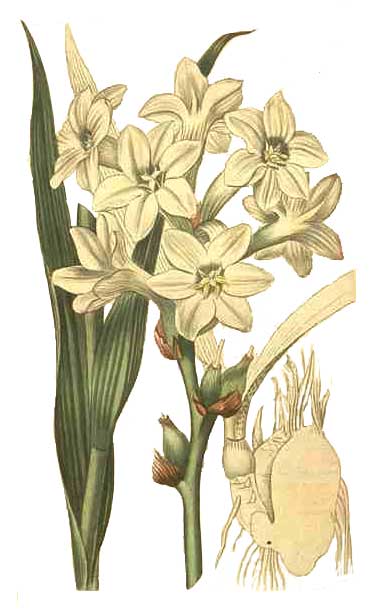
Botany
Azucena is an evergreen, with a stout and tuberous rootstock. Basal leaves are linear, 40 to 60 centimeters long, less than
1 centimeter wide, those on the stem much shorter. The inflorescence is erect,
0.5 to 1 meter high. Flowers are fragrant, waxy white, in pairs, 5 to 6
centimeters long, and the segments, oblong-lanceolate, 1 to 1.5 centimeters long.
Distribution
- Cultivated for its
fragrant flowers.
Constituents
- Volatile oil from
the flowers isolated tuberone.
- Methyl anthranilate has been noted in the tuberose oil.
- Inulin has been reported in the bulbs,
- Leaves yielded a 9,11 dehydrohecogenin 3-O glucose xylose galactoside, Kaempferol 3-O, α-D glucoside, Plianthoside B and C. (6)
- Essential oil from double-flower variety of tuberose were extracted by cold and hot enfleurage. The main chemical component detected in both enfleurage absolutes was methyl benzoate, while benzyl benzoate and pentacosane were the main chemical components in hexane and petroleum ether absolutes, respectively. (12)
 Properties Properties
- Diuretic, emetic, maturative.
- Considered aphrodisiac. (In India, unmarried girls are advised not be breathe its scent after dark.)
Parts utilized
Flowers, rhizomes.
Uses
Edibility
• Flowers are cooked. Used in vegetable soups or added to the Indonesian soy sauce, kecap. (13)
• Flowers are source of tuberosa-flower water. (13)
Folkloric
• Bulbs have been
used in decoction for gonorrhea.
• Poultice of bulbs employed as maturative in the formation of
pus in boils or abscesses.
• In Cambodia, Laos, and Vietnam, rhizomes are used to calm spasms and treat malaria. In China, rhizomes are used to treat burns, infections, and swellings. (9)
• In India, flowers used as diuretic
and emetic.
• In Sind, bulbs are dried, powdered
and used for gonorrhea.
Others
• Perfumery: Volatile oil used in perfumery.
• Aromatherapy: In aromatherapy, the warm and seductive scent is useful as a hypnotic for women suffering from insomnia and depressed with low sexual drive. (In India, unmarried girls are advised not be breathe its scent after dark.)
Studies
• Steroidal Glycosides / Cytotoxic Activity: Study of aerial parts of Polianthes tuberosa isolated a new bisdesmosidic cholestane glycoside and 3 new spirostanol saponins along with known cholestane glycoside. The compounds were evaluated for cytotoxic activity on HL-60 human promyelocytic leukemia cells. (2)
• Immunosuppressive Activity: Study yielded an acidic polysaccharide (ANK-102) from P tuberosa cells. Pretreatment with ANK-102 deteriorated the murine survival against lethal injection of Listeria monocytogenes, eliminated mainly by macrophages through T-cell mediated immune response. (1)
• Spirostanol and Furostanol Glycosides / Cytotoxicity: Study yielded six new steroid glycosides - two spirostanols, polianthosides B and C, and four furostanols, polianthosides D-G - from the fresh tubers of PT, together with seven known spirostanols and a known furostanol saponins. The cytotoxic activities against HeLa cells are reported. (4)
• Mosquito Larvicide: Study evaluated the larvicide and biting deterrence activity of buds of Polianthes tuberosa against Culex quinquefasciatus and Anopheles stephensi. Both crude and methanol extract showed efficient activity against Cx. quinquefasciatus suggesting use as a mosquito larvicide agent. (7)
• Antibacterial: The methanol extracts of the flower of Qiusqualis indica, Calothrophis gigantea and Polianthes tuberose showed significant antibacterial activity against microbes K. pneumonia, P. aeruginosa, P. mirabiilis, E. coli, MRSA and B. subtilis. Flower extracts of both dry and wet flowers of P. tuberose showed impact only on Proteus mirabilis and E coli at higher concentrations only. (8)
• Antianxiety / Inhalation of Essential Oil /
Clinical Trial: Randomized clinical trial evaluated the effect of inhalation of essential oils of P. tuberosa on test anxiety among 54 students. Results showed aromatherapy with essential oil was effective in reducing test anxiety. (14)
• Antioxidant / Cytotoxic / Antimicrobial / Membrane Stabilizing / Thrombolytic / Tuber: Study evaluated crude methanolic extract of tuber for biologic activities. In free radical scavenging assay, the extract showed significant activity with IC50 71.23 µg/ml, with high phenolic content of 113.49 mg of GAE/gm of extractives. Brine shrimp lethality assay, the crude extract and its fraction showed strong cytotoxic activity with LC50 of 3.56 and 9.31 µg/ml, respectively. In antibacterial assay, all plants samples showed mild to moderate activity against test pathogens. The plant also exhibited membrane stabilizing activity via inhibition in induced hemolysis models. In thrombolytic activity assay, crude extract showed 52.6% lysis of clot vs streptokinase at 66.8% clot lysis. (15)
• Antimicrobial / Flowers: Study evaluated flower extracts obtained by SC-CO2 extraction and solvent extractions for antimicrobial activity. The SC-CO2 and solvent extracts showed potency against S. aureus, P. aeruginosa, E. coli and C. albicans. The n-hexane extract showed the most promising result. (16)
Availability
Cultivated.
Wildcrafted. |



